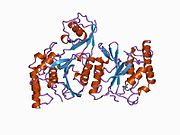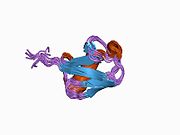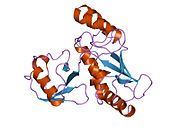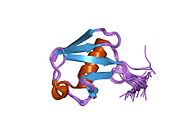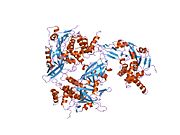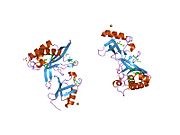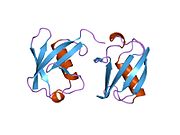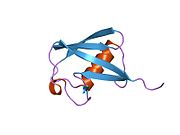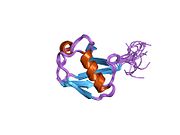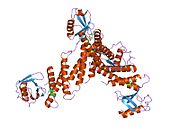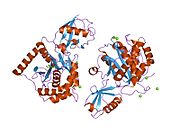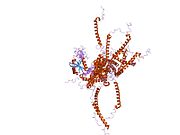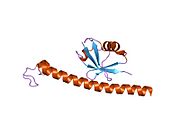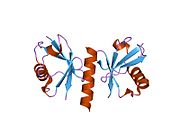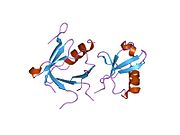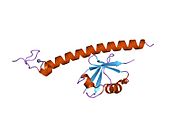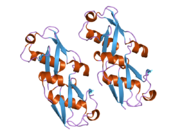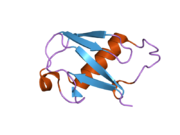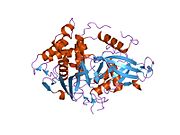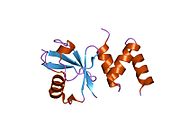Biology:Ubiquitin C
 Generic protein structure example |
Polyubiquitin-C is a protein encoded by the UBC gene in humans.[1][2][3] Polyubiquitin-C is one of the sources of ubiquitin, along with UBB, UBA52, and RPS27A.[4]
UBC gene is one of the two stress-regulated polyubiquitin genes (UBB and UBC) in mammals. It plays a key role in maintaining cellular ubiquitin levels under stress conditions.[5][6] Defects of UBC gene could lead to mid-gestation embryonic lethality.
Structure
Gene
UBC gene is located at chromosome 12q24.3, consisting of 2 exons. The promoter of the UBC gene contains putative heat shock elements (HSEs), which mediates UBC induction upon stress. UBC gene differs from UBB gene in the number of Ub coding units they contain.[5] Nine to ten Ub units were in the UBC gene.
Protein
In polyubiquitin-C, the C-terminus of a given ubiquitin molecule is covalently conjugated to either the N-terminal residue or one of seven lysine residues of another ubiquitin molecule.[7] Different linking of ubiquitin chains results in distinct conformations. There are 8 linkage types of polyubiquitin-C, and each type possesses the linkage-dependent dynamics and a linkage-specific conformation.[8][9]
Function
The diversity of polyubiquitin-C means that ubiquitylation contributes to the regulation of many cellular events. Polyubiquitin-C doesn’t activate the heat-shock response, but it plays a key role in sustaining the response. UBC gene transcription is induced during stress and provides extra ubiquitin necessary to remove damaged/unfolded proteins.[6][10] Polyubiquitin-C has important role in diverse biological processes, such as innate immunity, DNA repair and kinase activity.[11][12][13] Unanchored polyubiquitin-C are also key signaling molecules that connect and coordinate the proteasome and autophagy to eliminate toxic protein aggregates.[14]
Clinical significance
Loss of a single UBC allele has no apparent phenotype, while homozygous deletion of UBC gene leads to mid-gestation embryonic lethality due to a defect in fetal liver development, as well as a delay in cell-cycle progression and increased susceptibility to cellular stress.[6] It is also reported that homozygous deletion of UBC gene in mouse embryonic fibroblasts will cause decreased cellular Ub level and reduced viability under oxidative stress.[15]
Interactions
Polyubiquitin-C has been shown to interact with:
- BIRC2,[16][17][18]
- BSG,[19]
- CDC2,[20]
- CFAP298,[21]
- E2F1,[22]
- EGFR,[23][24][25]
- HDAC3,[20]
- HIF1A,[26][27][28]
- IRAK1,[29][30][31][32]
- KIAA0753.[33]
- MARK4,[34]
- MDM2,[35][36][37]
- NDUFA3,[38]
- NFE2L2,[39][40]
- NOTCH1,[41]
- NUAK1,[34]
- OPRK1,[42]
- P53,[23][35][36][37][43][44][45][46]
- PCNA[47][48][49]
- PARK2,[50][51]
- RIPK1,[16][29][52][53][54]
- RPS6KB1,[55]
- S100A10,[56]
- SCNN1A,[57][58]
- SCNN1G,[57][58]
- SFPQ,[59]
- SMAD3,[60][61]
- SMURF2,[62][63]
- SP1,[64]
- TRAF6,[29][30][52][65][66] and
- THRA.[20]
References
- ↑ "Localization of the human UBC polyubiquitin gene to chromosome band 12q24.3". Genomics 12 (4): 639–42. April 1992. doi:10.1016/0888-7543(92)90287-3. PMID 1315303.
- ↑ "Ubiquitin (UbC) expression in muscle cells is increased by glucocorticoids through a mechanism involving Sp1 and MEK1". The Journal of Biological Chemistry 277 (19): 16673–81. May 2002. doi:10.1074/jbc.M200501200. PMID 11872750.
- ↑ "Entrez Gene: UBC ubiquitin C". https://www.ncbi.nlm.nih.gov/sites/entrez?Db=gene&Cmd=ShowDetailView&TermToSearch=7316.
- ↑ "Regulatory mechanisms involved in the control of ubiquitin homeostasis". Journal of Biochemistry 147 (6): 793–8. June 2010. doi:10.1093/jb/mvq044. PMID 20418328.
- ↑ 5.0 5.1 "The human ubiquitin multigene family: some genes contain multiple directly repeated ubiquitin coding sequences". The EMBO Journal 4 (3): 755–9. March 1985. doi:10.1002/j.1460-2075.1985.tb03693.x. PMID 2988935.
- ↑ 6.0 6.1 6.2 "The mouse polyubiquitin gene UbC is essential for fetal liver development, cell-cycle progression and stress tolerance". The EMBO Journal 26 (11): 2693–706. June 2007. doi:10.1038/sj.emboj.7601722. PMID 17491588.
- ↑ "The ubiquitin code". Annual Review of Biochemistry 81: 203–29. 2012. doi:10.1146/annurev-biochem-060310-170328. PMID 22524316.
- ↑ "Ubiquitin chain conformation regulates recognition and activity of interacting proteins". Nature 492 (7428): 266–70. December 2012. doi:10.1038/nature11722. PMID 23201676. Bibcode: 2012Natur.492..266Y.
- ↑ "Unique structural, dynamical, and functional properties of k11-linked polyubiquitin chains". Structure 21 (7): 1168–81. July 2013. doi:10.1016/j.str.2013.04.029. PMID 23823328.
- ↑ "Sensitivity of mammalian cells expressing mutant ubiquitin to protein-damaging agents". The Journal of Biological Chemistry 276 (49): 46073–8. December 2001. doi:10.1074/jbc.M109023200. PMID 11598140.
- ↑ "Unanchored K48-linked polyubiquitin synthesized by the E3-ubiquitin ligase TRIM6 stimulates the interferon-IKKε kinase-mediated antiviral response". Immunity 40 (6): 880–95. June 2014. doi:10.1016/j.immuni.2014.04.018. PMID 24882218.
- ↑ "Virology. Unanchored ubiquitin in virus uncoating". Science 346 (6208): 427–8. October 2014. doi:10.1126/science.1261509. PMID 25342790.
- ↑ "Polyubiquitin chains: polymeric protein signals". Current Opinion in Chemical Biology 8 (6): 610–6. December 2004. doi:10.1016/j.cbpa.2004.09.009. PMID 15556404.
- ↑ "Proteasomes activate aggresome disassembly and clearance by producing unanchored ubiquitin chains". Molecular Cell 51 (6): 819–28. September 2013. doi:10.1016/j.molcel.2013.08.016. PMID 24035499.
- ↑ "Quantification of oxidative stress in live mouse embryonic fibroblasts by monitoring the responses of polyubiquitin genes". Biochemical and Biophysical Research Communications 404 (1): 470–5. January 2011. doi:10.1016/j.bbrc.2010.12.004. PMID 21144824.
- ↑ 16.0 16.1 "cIAP1 and cIAP2 facilitate cancer cell survival by functioning as E3 ligases that promote RIP1 ubiquitination". Molecular Cell 30 (6): 689–700. June 2008. doi:10.1016/j.molcel.2008.05.014. PMID 18570872.
- ↑ "Interaction of heat-shock protein 90 beta isoform (HSP90 beta) with cellular inhibitor of apoptosis 1 (c-IAP1) is required for cell differentiation". Cell Death and Differentiation 15 (5): 859–66. May 2008. doi:10.1038/cdd.2008.5. PMID 18239673.
- ↑ "Small molecules destabilize cIAP1 by activating auto-ubiquitylation". The Journal of Biological Chemistry 283 (14): 8961–8. April 2008. doi:10.1074/jbc.M709525200. PMID 18230607.
- ↑ "Interaction between CD147 and P-glycoprotein and their regulation by ubiquitination in breast cancer cells". Chemotherapy 54 (4): 291–301. 2008. doi:10.1159/000151225. PMID 18689982.
- ↑ 20.0 20.1 20.2 "Proteomic analysis of ubiquitinated proteins in normal hepatocyte cell line Chang liver cells". Proteomics 8 (14): 2885–96. July 2008. doi:10.1002/pmic.200700887. PMID 18655026.
- ↑ "Systematic and quantitative assessment of the ubiquitin-modified proteome". Molecular Cell 44 (2): 325–40. October 2011. doi:10.1016/j.molcel.2011.08.025. PMID 21906983.
- ↑ "The association of GSK3 beta with E2F1 facilitates nerve growth factor-induced neural cell differentiation". The Journal of Biological Chemistry 283 (21): 14506–15. May 2008. doi:10.1074/jbc.M706136200. PMID 18367454.
- ↑ 23.0 23.1 "Identification of c-Cbl as a new ligase for insulin-like growth factor-I receptor with distinct roles from Mdm2 in receptor ubiquitination and endocytosis". Cancer Research 68 (14): 5669–77. July 2008. doi:10.1158/0008-5472.CAN-07-6364. PMID 18632619.
- ↑ "A tale of two Cbls: interplay of c-Cbl and Cbl-b in epidermal growth factor receptor downregulation". Molecular and Cellular Biology 28 (9): 3020–37. May 2008. doi:10.1128/MCB.01809-07. PMID 18316398.
- ↑ "Ubc4/5 and c-Cbl continue to ubiquitinate EGF receptor after internalization to facilitate polyubiquitination and degradation". Molecular Biology of the Cell 19 (8): 3454–62. August 2008. doi:10.1091/mbc.E07-10-0988. PMID 18508924.
- ↑ "Identification of an alternative mechanism of degradation of the hypoxia-inducible factor-1alpha". The Journal of Biological Chemistry 283 (43): 29375–84. October 2008. doi:10.1074/jbc.M805919200. PMID 18694926.
- ↑ "Nitric oxide donor, (+/-)-S-nitroso-N-acetylpenicillamine, stabilizes transactive hypoxia-inducible factor-1alpha by inhibiting von Hippel-Lindau recruitment and asparagine hydroxylation". Molecular Pharmacology 74 (1): 236–45. July 2008. doi:10.1124/mol.108.045278. PMID 18426857.
- ↑ "Nur77 upregulates HIF-alpha by inhibiting pVHL-mediated degradation". Experimental & Molecular Medicine 40 (1): 71–83. February 2008. doi:10.3858/emm.2008.40.1.71. PMID 18305400.
- ↑ 29.0 29.1 29.2 "Ubiquitin chain editing revealed by polyubiquitin linkage-specific antibodies". Cell 134 (4): 668–78. August 2008. doi:10.1016/j.cell.2008.07.039. PMID 18724939.
- ↑ 30.0 30.1 "Lys63-linked polyubiquitination of IRAK-1 is required for interleukin-1 receptor- and toll-like receptor-mediated NF-kappaB activation". Molecular and Cellular Biology 28 (10): 3538–47. May 2008. doi:10.1128/MCB.02098-07. PMID 18347055.
- ↑ "Pellino 3b negatively regulates interleukin-1-induced TAK1-dependent NF kappaB activation". The Journal of Biological Chemistry 283 (21): 14654–64. May 2008. doi:10.1074/jbc.M706931200. PMID 18326498.
- ↑ "Interleukin-1 (IL-1) induces the Lys63-linked polyubiquitination of IL-1 receptor-associated kinase 1 to facilitate NEMO binding and the activation of IkappaBalpha kinase". Molecular and Cellular Biology 28 (5): 1783–91. March 2008. doi:10.1128/MCB.02380-06. PMID 18180283.
- ↑ KIAA0753 Gene - GeneCards | K0753 Protein | K0753 Antibody, (available at https://www.genecards.org/cgi-bin/carddisp.pl?gene=KIAA0753).
- ↑ 34.0 34.1 "Control of AMPK-related kinases by USP9X and atypical Lys(29)/Lys(33)-linked polyubiquitin chains". The Biochemical Journal 411 (2): 249–60. April 2008. doi:10.1042/BJ20080067. PMID 18254724. https://hal.archives-ouvertes.fr/hal-00478950/file/PEER_stage2_10.1042%252FBJ20080067.pdf.
- ↑ 35.0 35.1 "p14ARF interacts with DAXX: effects on HDM2 and p53". Cell Cycle 7 (12): 1836–50. June 2008. doi:10.4161/cc.7.12.6025. PMID 18583933.
- ↑ 36.0 36.1 "The tumour suppressor RASSF1A promotes MDM2 self-ubiquitination by disrupting the MDM2-DAXX-HAUSP complex". The EMBO Journal 27 (13): 1863–74. July 2008. doi:10.1038/emboj.2008.115. PMID 18566590.
- ↑ 37.0 37.1 "CARPs enhance p53 turnover by degrading 14-3-3sigma and stabilizing MDM2". Cell Cycle 7 (5): 670–82. March 2008. doi:10.4161/cc.7.5.5701. PMID 18382127.
- ↑ "A proteome-wide, quantitative survey of in vivo ubiquitylation sites reveals widespread regulatory roles". Molecular & Cellular Proteomics 10 (10): M111.013284. October 2011. doi:10.1074/mcp.M111.013284. PMID 21890473.
- ↑ "Cancer related mutations in NRF2 impair its recognition by Keap1-Cul3 E3 ligase and promote malignancy". Proceedings of the National Academy of Sciences of the United States of America 105 (36): 13568–73. September 2008. doi:10.1073/pnas.0806268105. PMID 18757741. Bibcode: 2008PNAS..10513568S.
- ↑ "Polymeric black tea polyphenols induce phase II enzymes via Nrf2 in mouse liver and lungs". Free Radical Biology & Medicine 44 (11): 1897–911. June 2008. doi:10.1016/j.freeradbiomed.2008.02.006. PMID 18358244.
- ↑ Wölfl, Stefan, ed (2008). "AIP4/Itch regulates Notch receptor degradation in the absence of ligand". PLOS ONE 3 (7): e2735. doi:10.1371/journal.pone.0002735. PMID 18628966. Bibcode: 2008PLoSO...3.2735C.
- ↑ "Agonist-promoted Lys63-linked polyubiquitination of the human kappa-opioid receptor is involved in receptor down-regulation". Molecular Pharmacology 73 (4): 1319–30. April 2008. doi:10.1124/mol.107.042846. PMID 18212250.
- ↑ "AIMP2/p38, the scaffold for the multi-tRNA synthetase complex, responds to genotoxic stresses via p53". Proceedings of the National Academy of Sciences of the United States of America 105 (32): 11206–11. August 2008. doi:10.1073/pnas.0800297105. PMID 18695251. Bibcode: 2008PNAS..10511206H.
- ↑ "Hedgehog signaling overrides p53-mediated tumor suppression by activating Mdm2". Proceedings of the National Academy of Sciences of the United States of America 105 (12): 4838–43. March 2008. doi:10.1073/pnas.0712216105. PMID 18359851. Bibcode: 2008PNAS..105.4838A.
- ↑ "Proteasome activator PA28 gamma regulates p53 by enhancing its MDM2-mediated degradation". The EMBO Journal 27 (6): 852–64. March 2008. doi:10.1038/emboj.2008.25. PMID 18309296.
- ↑ "Specific inhibition of Mdm2-mediated neddylation by Tip60". Cell Cycle 7 (2): 222–31. January 2008. doi:10.4161/cc.7.2.5185. PMID 18264029.
- ↑ "Polyubiquitination of proliferating cell nuclear antigen by HLTF and SHPRH prevents genomic instability from stalled replication forks". Proceedings of the National Academy of Sciences of the United States of America 105 (34): 12411–6. August 2008. doi:10.1073/pnas.0805685105. PMID 18719106. Bibcode: 2008PNAS..10512411M.
- ↑ "Human HLTF functions as a ubiquitin ligase for proliferating cell nuclear antigen polyubiquitination". Proceedings of the National Academy of Sciences of the United States of America 105 (10): 3768–73. March 2008. doi:10.1073/pnas.0800563105. PMID 18316726. Bibcode: 2008PNAS..105.3768U.
- ↑ "hMMS2 serves a redundant role in human PCNA polyubiquitination". BMC Molecular Biology 9: 24. 2008. doi:10.1186/1471-2199-9-24. PMID 18284681.
- ↑ "Parkin is ubiquitinated by Nrdp1 and abrogates Nrdp1-induced oxidative stress". Neuroscience Letters 440 (1): 4–8. July 2008. doi:10.1016/j.neulet.2008.05.052. PMID 18541373.
- ↑ "alpha-Synuclein aggregates interfere with Parkin solubility and distribution: role in the pathogenesis of Parkinson disease". The Journal of Biological Chemistry 283 (11): 6979–87. March 2008. doi:10.1074/jbc.M710418200. PMID 18195004.
- ↑ 52.0 52.1 "NUMBL interacts with TAB2 and inhibits TNFalpha and IL-1beta-induced NF-kappaB activation". Cellular Signalling 20 (6): 1044–51. June 2008. doi:10.1016/j.cellsig.2008.01.015. PMID 18299187.
- ↑ "c-IAP1 and c-IAP2 are critical mediators of tumor necrosis factor alpha (TNFalpha)-induced NF-kappaB activation". The Journal of Biological Chemistry 283 (36): 24295–9. September 2008. doi:10.1074/jbc.C800128200. PMID 18621737.
- ↑ "CARP-2 is an endosome-associated ubiquitin ligase for RIP and regulates TNF-induced NF-kappaB activation". Current Biology 18 (9): 641–9. May 2008. doi:10.1016/j.cub.2008.04.017. PMID 18450452.
- ↑ "Ribosomal protein S6 kinase 1 interacts with and is ubiquitinated by ubiquitin ligase ROC1". Biochemical and Biophysical Research Communications 369 (2): 339–43. May 2008. doi:10.1016/j.bbrc.2008.02.016. PMID 18279656.
- ↑ "Endothelial cell annexin A2 regulates polyubiquitination and degradation of its binding partner S100A10/p11". The Journal of Biological Chemistry 283 (28): 19192–200. July 2008. doi:10.1074/jbc.M800100200. PMID 18434302.
- ↑ 57.0 57.1 "Vasopressin-inducible ubiquitin-specific protease 10 increases ENaC cell surface expression by deubiquitylating and stabilizing sorting nexin 3". American Journal of Physiology. Renal Physiology 295 (4): F889–900. October 2008. doi:10.1152/ajprenal.00001.2008. PMID 18632802.
- ↑ 58.0 58.1 "Nedd4-2 isoforms ubiquitinate individual epithelial sodium channel subunits and reduce surface expression and function of the epithelial sodium channel". American Journal of Physiology. Renal Physiology 294 (5): F1157–65. May 2008. doi:10.1152/ajprenal.00339.2007. PMID 18322022.
- ↑ "A human protein-protein interaction network: a resource for annotating the proteome". Cell 122 (6): 957–68. September 2005. doi:10.1016/j.cell.2005.08.029. PMID 16169070.
- ↑ "Mesalazine negatively regulates CDC25A protein expression and promotes accumulation of colon cancer cells in S phase". Carcinogenesis 29 (6): 1258–66. June 2008. doi:10.1093/carcin/bgn122. PMID 18495657.
- ↑ "Axin and GSK3- control Smad3 protein stability and modulate TGF- signaling". Genes & Development 22 (1): 106–20. January 2008. doi:10.1101/gad.1590908. PMID 18172167.
- ↑ "Smurf2 is a TRAF2 binding protein that triggers TNF-R2 ubiquitination and TNF-R2-induced JNK activation". Biochemical and Biophysical Research Communications 374 (4): 752–7. October 2008. doi:10.1016/j.bbrc.2008.07.103. PMID 18671942.
- ↑ "AIMP1/p43 downregulates TGF-beta signaling via stabilization of smurf2". Biochemical and Biophysical Research Communications 371 (3): 395–400. July 2008. doi:10.1016/j.bbrc.2008.04.099. PMID 18448069.
- ↑ "Sumoylation of specificity protein 1 augments its degradation by changing the localization and increasing the specificity protein 1 proteolytic process". Journal of Molecular Biology 380 (5): 869–85. July 2008. doi:10.1016/j.jmb.2008.05.043. PMID 18572193.
- ↑ "Protein phosphatase 4 negatively regulates LPS cascade by inhibiting ubiquitination of TRAF6". FEBS Letters 582 (19): 2843–9. August 2008. doi:10.1016/j.febslet.2008.07.014. PMID 18634786.
- ↑ "The RING domain and first zinc finger of TRAF6 coordinate signaling by interleukin-1, lipopolysaccharide, and RANKL". The Journal of Biological Chemistry 283 (36): 24871–80. September 2008. doi:10.1074/jbc.M802749200. PMID 18617513.
Further reading
- "The role of viral and cellular proteins in the budding of human immunodeficiency virus". Acta Virologica 50 (2): 75–85. 2006. PMID 16808324.
- "Changes in expressions of proteasome and ubiquitin genes in human renal cancer cells". Cancer Research 51 (24): 6677–85. December 1991. PMID 1660345.
- "Unequal crossover generates variation in ubiquitin coding unit number at the human UbC polyubiquitin locus". American Journal of Human Genetics 44 (4): 534–42. April 1989. PMID 2564731.
- "Cloning and sequence analysis of a cDNA encoding poly-ubiquitin in human ovarian granulosa cells". Biochemical and Biophysical Research Communications 147 (2): 581–7. September 1987. doi:10.1016/0006-291X(87)90970-3. PMID 2820408.
- "A "double adaptor" method for improved shotgun library construction". Analytical Biochemistry 236 (1): 107–13. April 1996. doi:10.1006/abio.1996.0138. PMID 8619474.
- "Heterogeneous structure of the polyubiquitin gene UbC of HeLa S3 cells". Gene 175 (1–2): 179–85. October 1996. doi:10.1016/0378-1119(96)00145-X. PMID 8917096.
- "Large-scale concatenation cDNA sequencing". Genome Research 7 (4): 353–8. April 1997. doi:10.1101/gr.7.4.353. PMID 9110174.
- "Higher frequency of concerted evolutionary events in rodents than in man at the polyubiquitin gene VNTR locus". Genetics 148 (2): 867–76. February 1998. doi:10.1093/genetics/148.2.867. PMID 9504932.
- "Ubiquitin is covalently attached to the p6Gag proteins of human immunodeficiency virus type 1 and simian immunodeficiency virus and to the p12Gag protein of Moloney murine leukemia virus". Journal of Virology 72 (4): 2962–8. April 1998. doi:10.1128/JVI.72.4.2962-2968.1998. PMID 9525617.
- "Cloning of human polyubiquitin cDNAs and a ubiquitin-binding assay involving its in vitro translation product". Journal of Biochemistry 124 (1): 35–9. July 1998. doi:10.1093/oxfordjournals.jbchem.a022093. PMID 9644242.
- "Proteasome inhibition interferes with gag polyprotein processing, release, and maturation of HIV-1 and HIV-2". Proceedings of the National Academy of Sciences of the United States of America 97 (24): 13057–62. November 2000. doi:10.1073/pnas.97.24.13057. PMID 11087859. Bibcode: 2000PNAS...9713057S.
- "A role for ubiquitin ligase recruitment in retrovirus release". Proceedings of the National Academy of Sciences of the United States of America 97 (24): 13063–8. November 2000. doi:10.1073/pnas.97.24.13063. PMID 11087860. Bibcode: 2000PNAS...9713063S.
- "Ubiquitination of HIV-1 and MuLV Gag". Virology 278 (1): 111–21. December 2000. doi:10.1006/viro.2000.0648. PMID 11112487.
- "Late assembly domain function can exhibit context dependence and involves ubiquitin residues implicated in endocytosis". Journal of Virology 76 (11): 5472–9. June 2002. doi:10.1128/JVI.76.11.5472-5479.2002. PMID 11991975.
- "Screen and identification of proteins interacting with ADAM19 cytoplasmic tail". Molecular Biology Reports 29 (3): 317–23. September 2002. doi:10.1023/A:1020409217215. PMID 12463424.
- "Retroviruses have differing requirements for proteasome function in the budding process". Journal of Virology 77 (6): 3384–93. March 2003. doi:10.1128/JVI.77.6.3384-3393.2003. PMID 12610113.
- "A novel type of deubiquitinating enzyme". The Journal of Biological Chemistry 278 (25): 23180–6. June 2003. doi:10.1074/jbc.M301863200. PMID 12682062.
 |

